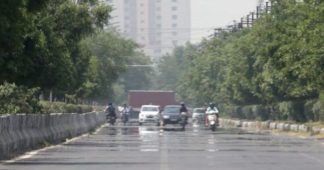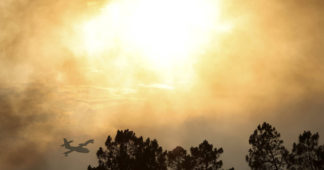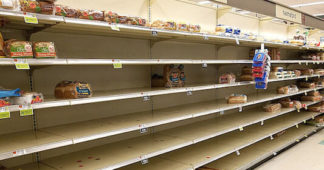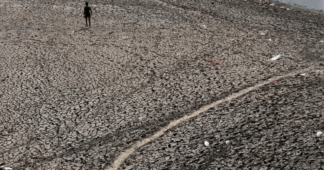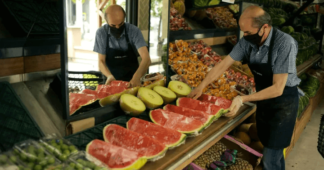By João Camargo*
Jun 12, 2023
The criminal profits of large multinational corporations in 2022 might seem to indicate a reversal of the historical trend for global profit decline of recent decades, but they are only a hiccup and a massive assault enabled by the privileges of the monopolists of global capital. The fall in profitability continues and the climate crisis is already and will continue to be the main factor in the current and future financial crises.
The inflationary spiral we are still living in was triggered by the oil companies’ choice to use their monopoly over the energy system to offset their falling profits during Covid lockdowns. This comes after decades of hooking the economy on fossil fuels in an absolute alliance with the political mainstream, with the complacency and sometimes even agreement of green and left-wing parties. All agreements have been torn up by now, only barbarism remains. However, on top of this assault produced by the imposition of unparalleled high prices, other imbalances beyond the control of the capitalist elite have begun to manifest themselves.
The economic and financial models are not designed for the climate crisis.
In 2022, Pakistan was submerged by the biggest floods in its history, with a third of the country under water, with over 30 million people displaced to other places and other countries. Pakistan is one of the world’s largest producers of cotton and textiles. The prices of textiles, of almost all kinds of clothing, have soared. Parts of Pakistan are still underwater. Several of the people who have been displaced will not return to where they were. The likelihood of mega-monsoons happening again in the coming years is high. The heat wave currently ravaging the Asian continent has—in the middle of moderate temperature months such as March or April— caused record highs in China, India, Bangladesh, Thailand, Vietnam, Laos, and others. This heat wave coincides with territories with high humidity so that large-scale deaths are already occurring (directly due to the heat and indirectly to people with health problems, the very young or elderly).
The abundance of cotton and textile production on a global level has been squeezed, prices have increased and it will not necessarily be possible to return to previous levels without further disruption.
Maize, wheat, and rice crops were affected by drought in the United States, Europe, and China. In California, the smallest rice area since the 1950s was planted in 2022 and the harvest will be about half that of a “normal” year. In the United States the winter wheat harvest has fallen by 25%. The disruption of the flow of grain in the Black Sea because of the Russian invasion of Ukraine added on top of this drastic decrease in supply even more concentration, increased global prices of cereals, bread, pasta. Some of this production could recover by 2023 if we do not experience a scorching summer in the Northern Hemisphere, but so far the historic drought on the Eurasian continent and in North America continues.
Agriculture in the mega-artificialized plastic prairie of southern Spain suffers drastic production declines and drives up the price of vegetables and legumes. The Alqueva Dam in Portugal and the absurd amount of criminal crops currently grown in the Alentejo region are now at the limits of viability. Although we have experienced the worst drought in Europe since the 16th century and the worst drought in the history of China in 2022, this was a year in which the climate phenomenon La Niña contributed to a global reduction in temperature. In 2023 this will not happen, and probably during the year El Niño will form in the Pacific Ocean, leading to a global increase in temperature.
We already live on another planet, not the one where all the exploitative relations, the institutions, and the banking and financial system that sustained the growth of capitalism were created.
To fight rising inflation, central banks and battalions of economists trained in the schools of suicidal capitalism chose to do what they learned: raise interest rates, to take money out of the economy, and make it squeeze. Everyone who had a loan saw the value of their loan increase, while the prices of all goods increased too. Many companies that had loans—everyone, therefore—also saw their operating costs increase, which will increase wage compression, eventually leading to layoffs and, in some cases, bankruptcy. Silicon Valley Bank went bankrupt as a result of rising interest rates and because it was a bank that specialized in debt, with a large amount invested in long-term US government treasury bonds, considered probably the safest investment in the world economy.
What happened to Silicon Valley Bank and the others will happen again and again in the future. Contagion to other banks will be more and more frequent and, with higher prices, will happen by other means as well. Household debt is increasing to combat high prices. As even the rare wage increases that do occur are below inflation, the level of debt is rising just to maintain similar living standards as before. As the likelihood of the price of fossil fuels controlled by private multinationals dropping significantly is so slim and as climate disasters such as droughts, floods and forest fires are taking away the general capacity to produce goods and services on a global scale, the climate crisis will continue to express itself directly as a cost of living crisis. This means that growing debts will, in increasing amounts, go unpaid. This means more banks going bust. But maybe it’s possible to cover all this with insurance, no?
No.
Global insurance premiums are on the rise because risk is moving from being risk to certainty. The banking industry’s close relationship with the insurance sector ensures that every climate catastrophe is also a financial crisis. And considering that risk is becoming or approaching a certainty in many cases, more and more insurers are refusing to insure investments, industrial projects, construction in dangerous zones, crops in flood or drought risk zones, and even general insurance on buildings, transport and other areas. They refuse because their business is to make a profit and because the previous distribution of risk is no longer the case and is only confirmed. All are much more dangerous and the risk of major climate catastrophes is widespread. Even when insurers don’t refuse to do the insurance, they increase premiums and therefore both people and businesses are paying more to have insurance. If you consider an area like flood-prone Pakistan or a state like California, one of the most important agricultural areas in the United States whose annual fires are now permanently devastating vast areas and even cities, which insurance companies will ever be able to insure all the damage caused?
None.
So who will pay for these disasters? Can you imagine? Well, the people of that country through the State, the ultimate guarantor. This will happen with countries or territories where the state is rich, like California. In cases like Pakistan, the answer is that nobody will pay for these disasters in their entirety. States, to pay for these fossil industry-produced disasters, will have to raise taxes or divert revenues from activities like Education or Health for recovery. In capitalism, we can take for granted that the funding of the repressive apparatus, the police and armies, will not be touched, in particular because social discontent has no way not to increase.
The rising cost of living is already a consequence of the climate crisis, high prices are and will continue to be imposed on people because overall supply is falling. All the weaknesses that already existed before—weak health systems, energy monopolies, unavailable, poorly built housing stock, touristification of cities, lack of quality public transport, and precarious mass employment—will be exacerbated. Health systems are on the verge of collapse, people can’t pay rents, can’t commute to work without exorbitant costs, and stop paying bills and debts. And banks threaten, evict, sue, but there is no money to save them. The result? A financial crisis. Not paying the people directly, the states pay, again the last guarantor of the financial system, reducing public services and social capacity, increasing public debts, and being pressured to sell public assets.
And they will always tell us that it is necessary to save the banks, because otherwise the whole economy collapses. They will guarantee the collapse of society to save the banks, once again. But this time it is not the same as previous financial crises.
The economic and financial models are not designed for the climate crisis. Just look at the Nobel prize winner in economics, Eric Nordhaus, and his models and the proposition that considering the cost-benefit, we could allow a global temperature increase of up to 4°C. Right now we have a global temperature increase of 1.1 to 1.3°C and there are already global scale resource and product shortages. One more degree and not only will there not be remotely the amount of products needed to sustain billions of people, there will be no international trade as anything even remotely stable. Economists and their models don’t realize what is or what will happen, they have generally been taught not to realize it.
The preponderance of the financial world in our societies means that this is also where we will see the world burn, economically and politically.
Exactly how the financial crises of the climate crisis will unfold is as diverse and multiple as the capitalist economy: bankruptcies because of high prices or interest rates, real estate crises, monetary crises when a country goes under water, debt crises when national production and tax revenues fall or banks, companies or insurance companies have to be saved, stranded assets when a government decides to bet on a failed and absurd project—we cannot help but point here to the stupidity of the project of a new Airport in Lisbon, of the cascade of dams to make an “Alqueva of the Tagus,” of the thousands of imbecile projects that abound in the national and international press every day.
With a global temperature increase of 1.1ºC to 1.2ºC we are already in a general financial crisis of general lack of income from capitalism, despite the neo-liberal parroting that we live in the best of all worlds. Quality of life is in decline across the world because of the climate crisis and the system we live in, which refuses to solve it. The profitable investments of the last seven decades no longer exist. That is why we see so much excitement and hype with artificial intelligence, cryptocurrencies, and other intangible assets. They are the search for yield that today has to be based primarily on divestment and on products whose verifiability is low. The time when investing in cement, cars, factories, roads, and construction had guarantees of profit (even if brokered and favoured by the state, based on the idea of guaranteed future growth and profitability) is over. What is left is chaos and alienation.
On the other hand, alienation is widespread among the population and so it becomes very difficult to translate that the financial crises in which capitalism has always lived now also have an umbilical link to the climate crisis. It is on the basis of this understanding that some of the anti-systemic alliances essential to an ecosocialist political breakthrough can and must be made.
The climate crisis will be the mother of all financial crises, because it is the fundamental crisis of the human species and will have repercussions on all human systems. The preponderance of the financial world in our societies means that this is also where we will see the world burn, economically and politically.
The choice to design political programs that abandon the need for the urgent closure of fossil industry or that base the solution to the crisis on wage increases that do not entail any fundamental redistribution of power are proposals almost as alienated as the proposals of the capitalist elite.
We must not only know the current crises but use them at all times to propose the political programs of rupture necessary to stop the climate crisis and capitalism. This bridge is expressed in proposals like the Last Winter of Gas, which promotes a multi-tactic articulation and an alliance between different political groups in the simultaneous fight against the social, economic, and climate crisis. The break with the capitalist system and the road to climate chaos will have to be an articulated, international, and incisive process. The successive financial crises cannot be allowed to pass by as key moments for action.
* Joao Camargo is a climate activist in grassroots movement Climaximo in Portugal and in the Climate Jobs campaign. He’s an environmental engineer and climate change researcher at the University of Lisbon and the author of two books: Climate Change Combat Manual (in Portugal and Spain) and Portugal in Flames – How to rescue the forests.
We remind our readers that publication of articles on our site does not mean that we agree with what is written. Our policy is to publish anything which we consider of interest, so as to assist our readers in forming their opinions. Sometimes we even publish articles with which we totally disagree, since we believe it is important for our readers to be informed on as wide a spectrum of views as possible.
